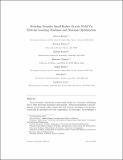| dc.contributor.author | Furfaro, Roberto | |
| dc.contributor.author | Barocco, Riccardo | |
| dc.contributor.author | Linares, Richard | |
| dc.contributor.author | Topputo, Francesco | |
| dc.contributor.author | Reddy, Vishnu | |
| dc.contributor.author | Simo, Jules | |
| dc.contributor.author | Le Corre, Lucille | |
| dc.date.accessioned | 2021-10-27T20:05:01Z | |
| dc.date.available | 2021-10-27T20:05:01Z | |
| dc.date.issued | 2021 | |
| dc.identifier.uri | https://hdl.handle.net/1721.1/134439 | |
| dc.description.abstract | Close proximity operations around small bodies are extremely challenging due to their uncertain dynamical environment. Autonomous guidance and navigation around small bodies require fast and accurate modeling of the gravitational field for potential on-board computation. In this paper, we investigate a model-based, data-driven approach to compute and predict the gravitational acceleration around irregular small bodies. More specifically, we employ Extreme Learning Machine (ELM) theories to design, train and validate Single-Layer Feedforward Networks (SLFN) capable of learning the relationship between the spacecraft position and the gravitational acceleration. ELM-base neural networks are trained without iterative tuning therefore dramatically reducing the training time. Analysis of performance in constant density models for asteroid 25143 Itokawa and comet 67/P Churyumov-Gerasimenko show that ELM-based SLFN are able learn the desired functional relationship both globally and in selected localized areas near the surface. The latter results in a robust neural algorithm for on-board, real-time calculation of the gravity field needed for guidance and control in close-proximity operations near the asteroid surface. | |
| dc.language.iso | en | |
| dc.publisher | Elsevier BV | |
| dc.relation.isversionof | 10.1016/J.ASR.2020.06.021 | |
| dc.rights | Creative Commons Attribution-NonCommercial-NoDerivs License | |
| dc.rights.uri | http://creativecommons.org/licenses/by-nc-nd/4.0/ | |
| dc.source | Other repository | |
| dc.title | Modeling Irregular Small Bodies Gravity Field Via Extreme Learning Machines and Bayesian Optimization | |
| dc.type | Article | |
| dc.contributor.department | Massachusetts Institute of Technology. Department of Aeronautics and Astronautics | |
| dc.relation.journal | Advances in Space Research | |
| dc.eprint.version | Author's final manuscript | |
| dc.type.uri | http://purl.org/eprint/type/JournalArticle | |
| eprint.status | http://purl.org/eprint/status/PeerReviewed | |
| dc.date.updated | 2021-05-06T12:47:14Z | |
| dspace.orderedauthors | Furfaro, R; Barocco, R; Linares, R; Topputo, F; Reddy, V; Simo, J; Le Corre, L | |
| dspace.date.submission | 2021-05-06T12:47:17Z | |
| mit.journal.volume | 67 | |
| mit.journal.issue | 1 | |
| mit.license | PUBLISHER_CC | |
| mit.metadata.status | Authority Work and Publication Information Needed | |
